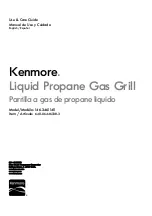
18
BATTERY REPLACEMENT:
1. Remove grease tray.
2. Pull battery downwards. (This may require use of pliers - Fig 13.)
3. Re-install upward and push to snap - Fig 15. (Polarity as shown
in Fig. 14).
NOTE: Battery condition should be checked at least once a year.
GRILL RACKS:
The easiest way to clean the grill is immediately after cooking is completed and after turning off the
flame. Wear a barbeque mitt to protect your hand from the heat and steam. Dip a fine brass bristle
barbeque brush in tap water and scrub the hot grill. Dip the brush frequently in the bowl of water.
Steam, created as water contacts the hot grill, assists the cleaning process by softening any food
particles. The food particles will fall onto the ceramic rods and burn or fall into the drip tray. If the grill
is allowed to cool before cleaning, cleaning will be more difficult.
DRIP TRAYS:
The full width drip trays will collect grease from the grill section and boil overs and spills from the side
burners. Allow the pan and its contents to cool before attempting to clean. Clean grease from the pan
often to avoid the possibility of a grease fire.
STAINLESS STEEL:
The Grill is made from non-rusting and non-magnetic stainless steel. After initial usage, areas of the
grill may discolor from the intense heat given off by the burners, this is normal. There are many
different stainless steel cleaners available. Always use the mildest cleaning procedure first, scrubbing
in the direction of the grain. To touch up noticeable scratches in the stainless steel, sand very lightly
with dry 100 grit emery paper in the direction of the grain. Specks of grease can gather on the surfaces
of the stainless steel and bake on to the surface and give the appearance of rust. For removal use an
abrasive pad (Scotch Brite is good) in conjunction with a stainless steel cleaner. Always rub in the
direction of the grain.
Note: Stainless steel tends to accumulate surface oxidation in presence of chlorides and sulfides
specially in coastal areas. To ensure oxidation prevention, wash all stainless steel surfaces
every 3-4 weeks with fresh water and stainless cleaner.
FIG. 14
CARE AND CLEANING
FIG. 15
FIG. 13











































